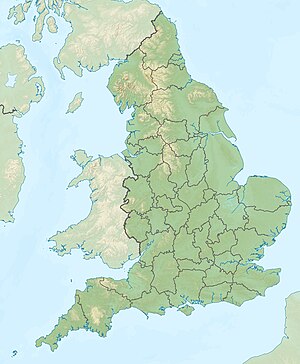Deal Castle
| Deal Castle | ||
|---|---|---|
|
Aerial view |
||
| Creation time : | 1539-1540 | |
| Conservation status: | receive | |
| Geographical location | 51 ° 13 '6.7 " N , 1 ° 24' 14" E | |
|
|
||
Deal Castle is a former coastal fortification in Kent in the UK . The former fortress, protected as a Scheduled Monument , is located in the middle of the city of Deal and is considered the largest and best preserved coastal fortification from the time of Henry VIII .
history
The fortress was part of the chain of fortresses comprising 20 castles that Henry VIII had built to ward off feared Spanish and French invasions and was completed in 1540 after just one year of construction. Together with Walmer Castle, two kilometers south, and Sandown Castle , two kilometers north, the fortresses were supposed to protect the coast off The Downs from enemy landings.
The only military action the fortress saw was in the English Civil War . The garrisons of the three fortresses at Deal had defected to the royalists in 1648, and it took parliamentary troops three months to retake the fortresses. Deal Castle was seriously damaged. After the end of the Napoleonic Wars, the complex was abandoned as a coastal fortification and only served as the residence of a fortress governor. The fortress was damaged by German bombs in 1941, and has been managed by English Heritage since 1951 and can be visited.
investment
The fortress was built according to plans by Stephan von Haschenperg and has a concentric , perfectly symmetrical shape. A round central tower is surrounded by six half-height, semicircular bastions . Around this is a ring of six lower, also semicircular bastions, which are separated from the central tower and the inner bastions by an inner ditch. In the event of a defense, the core of the facility could still be defended if attackers had already penetrated the outer bastions. Each bastion was equipped with cannons and loopholes for muskets, a total of over 100 cannons could be set up in the fortress. The whole fortress is surrounded by a dry, walled moat. The only access is via a drawbridge to the western outer bastion.
The symmetrical ground plan of the fortress is interpreted as a portrait of the Tudor rose , the complex was in theory the perfect form of defense. The round and low bastions should not offer the opposing cannonballs a single, flat impact surface, while the bastions covered each other. In practice, however, the round bastions created blind spots that would have made it very difficult for the defenders to fight attackers who had penetrated to the base of the wall. This problem was recognized during the construction of the first coastal fortifications by Henry VIII, so that the later built coastal fortifications were fortified with V-shaped bastions in the Italian manner.
Web links
Individual evidence
- ↑ Fortified Places: Deal Castle. Retrieved December 10, 2011 .
- ↑ The Heritage Trail: Deal Castle. (No longer available online.) Archived from the original on February 7, 2012 ; Retrieved December 20, 2011 . Info: The archive link was inserted automatically and has not yet been checked. Please check the original and archive link according to the instructions and then remove this notice.
- ↑ Martin Brice: Castles and fortifications: From antiquity to the end of the 20th century. Weltbild, Augsburg 1991, ISBN 3-8289-0730-X , p. 78ff.


